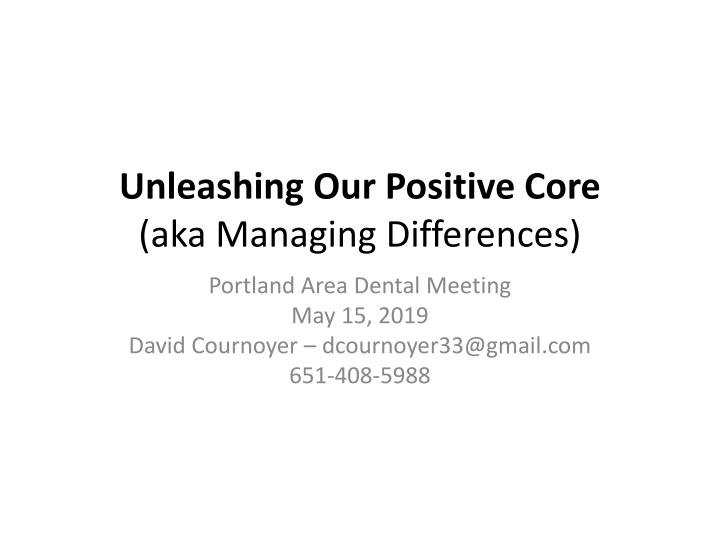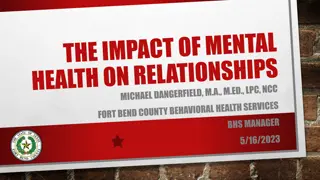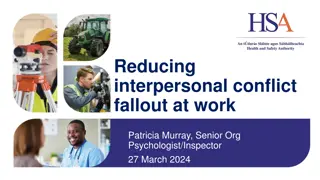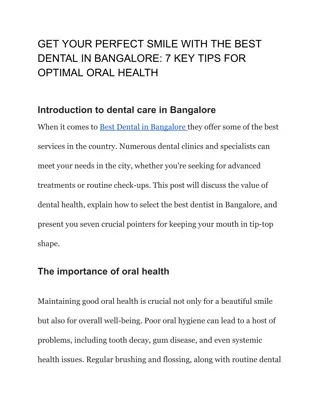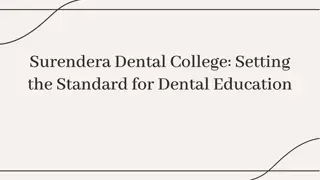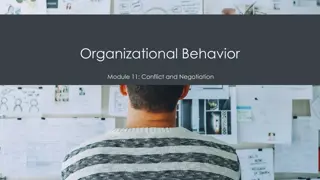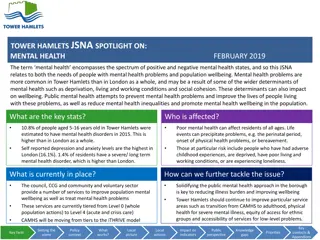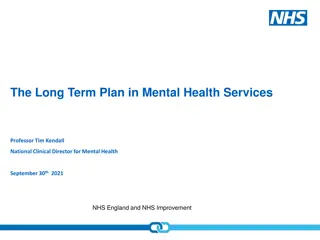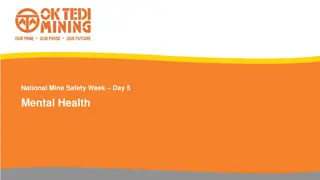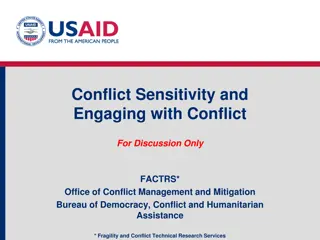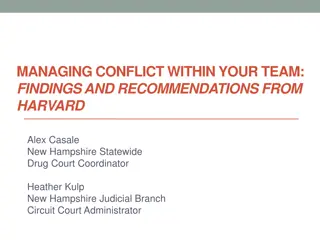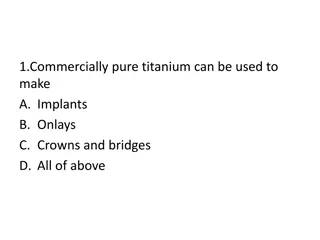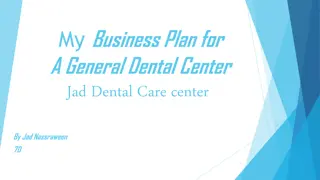Workplace Conflict Management Strategies and Mental Health in a Dental Meeting
Explore sources of workplace conflict, stress, and trauma alongside effective conflict management styles in a dental meeting setting. Discover how workplace climates impact mental health and learn from the Mental Health America study insights. Enhance your skills in managing differences and unleashing your positive core as a leader and helper.
Download Presentation

Please find below an Image/Link to download the presentation.
The content on the website is provided AS IS for your information and personal use only. It may not be sold, licensed, or shared on other websites without obtaining consent from the author.If you encounter any issues during the download, it is possible that the publisher has removed the file from their server.
You are allowed to download the files provided on this website for personal or commercial use, subject to the condition that they are used lawfully. All files are the property of their respective owners.
The content on the website is provided AS IS for your information and personal use only. It may not be sold, licensed, or shared on other websites without obtaining consent from the author.
E N D
Presentation Transcript
Unleashing Our Positive Core (aka Managing Differences) Portland Area Dental Meeting May 15, 2019 David Cournoyer dcournoyer33@gmail.com 651-408-5988
Warm-up Questions What are you most excited about in your life (that doesn t mostly involve family)? What do you need to be most effective as a helper and leader? Conditions, support, resources, etc.
Sources of Workplace Conflict Personality & communication style Assumptions & misinformation Unmet expectations Different approaches to work Different behavioral norms Systemic issues Lack of communication, lack of resources, differing or oppositional goals, ineffective policies/procedures, unclear decision making processes Non-work stress & trauma
Stress & Trauma Trauma is the state of overwhelmed in the body .Trauma is more than an event. The event is over. The trauma lives in me, like a jolt of electricity. Trauma is the unfinished cycle of energy stored in our nervous system .It becomes a lifestyle of reaction, hypervigilance, anger and self-medication. - Darryl Tonemah, PhD
Some Workplace Climates 17,000 workers in 19 industries completed Mental Health America s 2015-6 survey: 63% of employees experienced isolation because of a hostile work environment 63% stating that work stress negatively affected their mental and physical health. 71% of employees reported speaking poorly of their organization (including boss and co- workers) and wanting to leave their jobs.
Mental Health America Study 21% of respondents felt that they were paid what they deserved 36% felt they could rely on supervisor support 34% felt they could rely on colleague support The healthiest workplaces were health care, financial services and nonprofits. The least healthy were manufacturing, retail and food/beverage.
Conflict Management Styles Accommodate Avoid Compromise Collaborate Compete
Communicating in Conflict Active listening - open-ended questioning, paraphrasing, acknowledging feelings, non-verbal encouragers and summarizing What or how questions (Not why ) Be assertive and non-blaming describe your concern, the impact of the challenge, and your needs and wants Use I statements - I statements focus on your experience, thoughts, feelings, reactions and decisions and not on any beliefs or judgments about the other person
Active Listening Open-ended questioning - What or how What did you think about that? How did you feel? Paraphrasing Let the other person know they ve been heard, check for meaning. Acknowledging feelings After checking words, check feelings. Providing non-verbal encouragement Summarizing Headlines the discussion and allows for editing.
When the Co-worker Is Angry Anger typically results from Frustration: Not getting what I want, especially if I m expecting to get it; Feeling others don t respect us or care how we feel. Decide whether to engage. Acknowledge the anger or emotion. Stay calm yourself. Ask about the problem. Don t continue if the anger builds.
Approaching A Colleague Don t try to talk when there s anger. Actively reduce your stress. Know yourself and your own anger thresholds. Consider the idea that your perception of the event, person, or situation is creating the feeling of anger. Ask for help if needed. Take steps to solve the problem.
Approaching A Colleague Analyze and think about the problem. Set time to have a discussion. Communicate. Be ready to listen. Work together to solve the problem. Don t vent to others. Keep working at it.
Typical Types of Listening Superficial Listening I m listening to you but I m distracted by my own thoughts. Self-reverential I m listening but I will nudge the conversation so it becomes about me. Fix-it I m listening but I want to fix your issue (so that it becomes about me). Engaged Listening Full attention, I want to better understand, It s all about you.
QUALITY OF CONVERSATIONS
Effective Teams MIT, et al. researchers, 2008: What distinguished the good teams from the dysfunctional groups was how teammates treated one another. The right norms could raise a group s collective intelligence. In 2016, Project Aristotle researchers concluded that understanding and influencing group norms were the keys to improving Google s teams.
Effective Teams: Communication On the good teams, members spoke in roughly the same proportion, a phenomenon the researchers referred to as equality in distribution of conversational turn-taking. On some teams, everyone spoke during each task; on others, leadership shifted among teammates from assignment to assignment. In each case, by the end of the day, everyone had spoken roughly the same amount.
Effective Teams: Empathy Good teams all had high average social sensitivity they were skilled at intuiting how others felt based on their tone of voice, their expressions and other nonverbal cues. They seemed to know when someone was feeling upset or left out.
Google: Effective Teams PSYCHOLOGICAL SAFETY - shared belief held by members of a team that the team is safe for interpersonal risk-taking . a sense of confidence that the team will not embarrass, reject or punish someone for speaking up a team climate characterized by interpersonal trust and mutual respect in which people are comfortable being themselves. (Amy Edmondson, Harvard Business School)
What are your teams norms of behavior?
Norms Ask individuals on the team about their core values Identify shared values Identify (and discuss) what each value looks like in practice Identify and discuss what it looks like when a value is not practiced
Break Team Patterns Use variety and creativity have fun Rotate staff meeting place/time/leader Use a check-in question Do/make something together Conduct quick post-meeting + / Ask individuals for their love language Consider making conscious relationship pairs
Coaching for The Positive Core Process that supports individuals to make more conscious decisions and take new action Helps individuals identify and build on their strengths Moves a person from where they are to where they want to be Fosters new levels of reflection, awareness, communication, accountability and engagement
Things Coaches Will Hear High dreams big-picture possibility, future longing, long-term strategies Low dreams smaller dream to address a need or want, requires immediate shift or action Barriers real or perceived limitations, choices, current reality Clarity & understanding- visualization/realization/ actualization of goals, growth, reality, resources, opportunity, options, a way forward or a sense of what s next
Empowering Questions Provide people a guided avenue or path toward accessing inner wisdom. Invite the person s wisest self to respond. Are the open-ended questions that allow people to focus on possibilities and solutions (empowering) rather than perceived limitations (disabling).
Some Empowering Questions What s the way forward? What do you want your life to be about? Who do you want to be and what experiences do you want to create? How does that serve you in terms of who you are and who you want to be? How are you giving your best where you have your best to give?
Some Empowering Questions What do you want to accomplish? What do you want to do more of each day? What do you want to spend less time on? If this situation were to never change, what s the one quality you need to truly enjoy it? What s right with this picture? What s the most effective thing for me to focus on?
Some Empowering Questions What s the goal? ... What are the goals? What would success look like? What do you need to be successful? How are you creating the results you want? What s the best thing for right now? What s wearing you down? What s lifting you up?
Encouraging A Conscious Relationship Two-way partnership Shares values, experience, perceptions and goals more deeply Builds trust, vulnerability and deeper satisfaction in sharing each other s stories and journey Require responsibility, vulnerability, listening, trust and commitment plus authenticity ( full selves )
Forming A Conscious Relationship Safety Hosting yourself focus inward and access the deepest intention for the partner and you Physical stance - The theory is that humans feel confi- dent and powerful when standing and ready to move Metaphoric stance What picture or visual represents your role in support and empowering? Coaching commitment Summary pledge for every coaching engagement Hosting your partner hold their agenda, stay focused, listen for big picture plus the moment
Final Thoughts Be people. Have fun. Unleash your best, full self (not just your work self). Break the pattern. Invest in relationships. Ask people what they think. Listen. Adapt. Let go. Make time. Live the meme! You have to DO it, try it, take risks, be vulnerable. PDSA.
